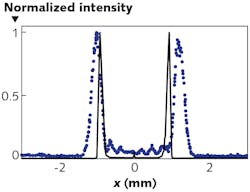Hollow Bessel beam could guide cold atoms for physics experiments

Manipulating cold atoms in an ultrahigh vacuum is central to numerous sorts of fundamental and applied physics experiments, including quantum sensing, atom interferometry, optical one-way barriers, particle flux detection, collisional dynamics of atoms, and others. Often, cold atoms are obtained by heating a solid piece of some element in vacuum to increase the partial pressure around the sample so that it emits atoms, collecting the atoms in a trap such as a magneto-optical trap and cooling them, and then transferring the atoms from the preparation chamber to a separate science chamber. The transfer methods consist of different lossy magnetic or magneto-optical techniques; the loss can be reduced by using a magnetic waveguide, but this only works for atoms that are paramagnetic in their ground state.
Now, scientists at the University of São Paulo (São Carlos, Brazil) have come up with a nonmagnetic technique to channel cold atoms from one vacuum chamber to another: a hollow Bessel light beam into which cold atoms are injected. The beam, which can be created using optics consisting of one axicon lens and one conventional focusing lens, acts as a cylindrical light trap that conveys atoms along the resulting light tube. Computer simulations of a Bessel beam produced by an axicon from a Gaussian laser beam with a 0.5 mm diameter, a 461 nm wavelength, and a power of 10 mW show the ability to channel cold atoms over lengths of a couple hundred millimeters. A hollow Bessel beam profile was measured experimentally and corresponds well with the simulation. For strontium atoms precooled to 10 mK, simulated loading efficiency was 20%, but could be increased to 80% by increasing Bessel beam power and tuning the laser wavelength precisely. Reference: D. Rivero et al., arXiv:2010.09792v1 [physics atom-ph] (Oct. 19, 2020).
About the Author
John Wallace
Senior Technical Editor (1998-2022)
John Wallace was with Laser Focus World for nearly 25 years, retiring in late June 2022. He obtained a bachelor's degree in mechanical engineering and physics at Rutgers University and a master's in optical engineering at the University of Rochester. Before becoming an editor, John worked as an engineer at RCA, Exxon, Eastman Kodak, and GCA Corporation.
